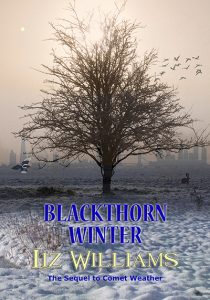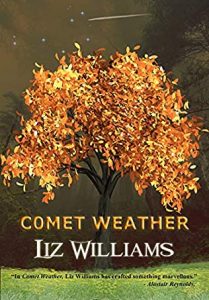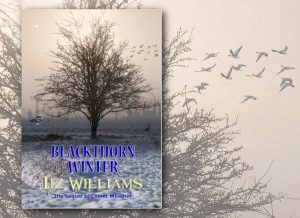BLACKTHORN WINTER by Liz Williams (BOOK REVIEW)
‘“What, you mean they aren’t human?”
“No, I mean they aren’t people. Not like you and me. Well, not like me, anyway. They look like us, when they want to, but they don’t breed like us and they’re – it’s like their clothes. You see them in all this designer-type stuff, cloth of gold and velvet and that, but when you look out of the side of your eye they’re dressed in rags. They’re like that themselves. They’re all scraps and patches, bits of greed and lust and envy and spite. And some good things too, sometimes. But not often. They’re not supposed to have souls in the old folklore and I think that’s actually right. They’re hollow and they know it. They’re shells and they’re constantly trying to fill that lack.”’
 Blackthorn Winter (2021) is the wonderful sequel to Liz Williams’ Comet Weather (2020), one of my favourite books from last year. Blackthorn Winter matches the charm, magic and lyricism of its predecessor, delivering the continuing adventures of the Fallow sisters. Like Comet Weather, the main thread its plot resolves over the course of the novel whilst teasing out aspects of the ongoing storyline. Williams once again combines stellar character work with exploration of British folklore and fairy tales, leaving the reader with the sense that the fantastic is hiding in the land around us, just in the corner of our vision.
Blackthorn Winter (2021) is the wonderful sequel to Liz Williams’ Comet Weather (2020), one of my favourite books from last year. Blackthorn Winter matches the charm, magic and lyricism of its predecessor, delivering the continuing adventures of the Fallow sisters. Like Comet Weather, the main thread its plot resolves over the course of the novel whilst teasing out aspects of the ongoing storyline. Williams once again combines stellar character work with exploration of British folklore and fairy tales, leaving the reader with the sense that the fantastic is hiding in the land around us, just in the corner of our vision.
Following the events of Comet Weather, Bee, Stella, Serena and Luna are preparing for Christmas celebrations at Mooncote, their family home in Somerset. Their mother Alys has disappeared again but has promised to return for the holidays. However the festive season soon proves less restful than anticipated. Serena’s latest collection is mysteriously destroyed just in time to ruin fashion week for her, allowing the rich and charming Caspar Pharoah to come to her aid. But there are rumours that her new benefactor is not all he appears. Bee finds a green-skinned girl called Aln in the churchyard and winds up looking after her, but no one can figure out where she comes from or what language she speaks. Meanwhile as Luna’s pregnancy progresses she starts to slip through time and worlds with increasing frequency, and Stella receives a warning from a magpie which leads her to team up with the mysterious Ace, an expert in London occult lore. Ben, Serena’s ex, has vanished without a trace. All these mysteries are enough to turn the Fallow sisters’ holidays upside down, and that’s before Alys returns and starts acting strange, leading the sisters to suspect that whatever has joined them for the holidays may not be their mother at all.
It is an utter delight to return to the warm and inviting world that Williams has created, and seeing the Fallow sisters again is like seeing old friends. As in Comet Weather, Williams excels at familial character interactions, and while the sisters have dealt with many of the fissures in their relationships from the first book, their suspicions of the returned Alys allow other tensions to show themselves and allows a different dynamic to grow between them. There is much joy to be had in spending Christmas with the Fallows and their partners, and seeing how they navigate the holiday traditions as witches but also as a family. However Williams does not allow her characters or her readers to get overly comfortable, as the supernatural makes itself felt again in ways both awe-inspiring and sinister. This time Williams draws on the minotaur and the labyrinth, as well as the history of the Romans in Britain, the Green Children of Woolpit, the Wild Hunt and more. She even succeeds in exploring the occult history of London, a recurring theme in the Weird and Urban Fantasy, and putting her own original spin on it. Once again the deftness with which Williams interweaves folklore, reality and the history of Britain is admirable.
 If Comet Weather was more Bee and Serena’s book, in Blackthorn Winter we get more of a focus on Stella and Luna. Stella’s adventures with Ward and Ace around London are a particular highlight of the novel, and include run-ins with William Blake and various other historical figures who have stayed on past their death to look after the city. Luna gets to go on an adventure between worlds with Aln, where she travels through the Severn Estuary, Roman Britain and the ancient forests of England. These sections have more than a touch of Robert Holdstock’s wonderful Mythago Wood (1984) and Lavondyss (1988) in their exploration of the mythological woods that connect different worlds through time, space and story. However like Comet Weather, Blackthorn Winter is a true ensemble piece, and Bee and Serena still get plenty to do. Williams expertly balances her four viewpoint characters, and the hints we are getting of a wider conflict between the Fallow sisters and the Fae who keep trying to encroach on our reality point to great things for the next two volumes of the series.
If Comet Weather was more Bee and Serena’s book, in Blackthorn Winter we get more of a focus on Stella and Luna. Stella’s adventures with Ward and Ace around London are a particular highlight of the novel, and include run-ins with William Blake and various other historical figures who have stayed on past their death to look after the city. Luna gets to go on an adventure between worlds with Aln, where she travels through the Severn Estuary, Roman Britain and the ancient forests of England. These sections have more than a touch of Robert Holdstock’s wonderful Mythago Wood (1984) and Lavondyss (1988) in their exploration of the mythological woods that connect different worlds through time, space and story. However like Comet Weather, Blackthorn Winter is a true ensemble piece, and Bee and Serena still get plenty to do. Williams expertly balances her four viewpoint characters, and the hints we are getting of a wider conflict between the Fallow sisters and the Fae who keep trying to encroach on our reality point to great things for the next two volumes of the series.
Williams has again written a beautiful and life-affirming fantasy that brings light and warmth during the strange times we find ourselves in. Along with her wonderful character work, the novel is striking because of Williams’ masterful command of prose and imagery. Like its predecessor, Blackthorn Winter deserves to take its place in the ranks of great British fantasy that explores the mythology and folklore of the British Isles with wisdom and invention. I look forward to reading the next two books in the series, which have been picked up by NewCon press, and are sure to be highlights of the coming years in Fantasy.

